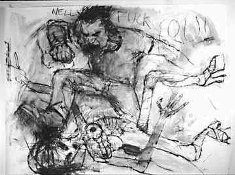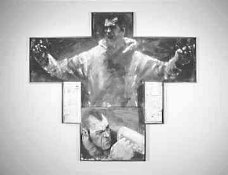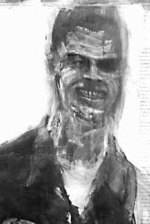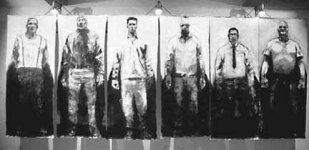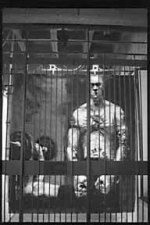Winter 1999, Volume 16.2
Art
Fletcher Booth
.png)
Fletcher Booth was born in Joplin, Missouri, and raised in Kansas and Oklahoma. He graduated from high school in Wichita, Kansas and received a Bachelor of Fine Arts from the University of Kansas, in Lawrence. He is currently finishing a Masters of Fine Arts at the University of Utah
In some of my earlier work, I used short stories written by a friend, and I made images to go with them. "College" is an example. That story is the rambling of a mad man, and it tells about this guy going to college and being dissatisfied. The image of a cross comes from the part of the story where the guy decides that he’s not good enough and doesn’t fit in with what’s happening at the university. "College" is really two images—at the bottom the guy is trying to drink his problems away and at the top he’s saying "I am guilty of such crimes, though never have I thought of them nor committed them. Crucify me."
Anyway, from making images to fit existing stories, it was only natural that I started developing narratives in some of my other pictures. Before I started using story narratives, I think some of my images may have been too ambiguous—sometimes I wasn’t even sure what they were about. I only knew they were images I needed to bring out. By developing the narrative, I think my art has become more powerful for me and for the audience. A story lets you make a more personal connection with the art, so you’re not too separated from it, and it has more impact. I also have even more confidence now in what I’m doing, which has to do with that idea of self-discovery. I know that "self-discovery" is a kind of cliché, but if you can take things about yourself and learn from them, and turn them into images that are separated but also connected (even if you’re the only one who knows about the connection) I think the art will come across as having more meaning and will seem more real to the audience.
A lot of my recent work is becoming more personal, maybe even autobiographical, but in an ambiguous and ubiquitous way. I like telling stories with my art, and I’ll have six or seven different works that go with a single narrative. Usually the work is spread out in different places though, so when you look at one image you won’t see the whole story, but it’s there. In most of my work, I’m also trying to make some kind of connection with myself. For example, I’m drawing aliens in my art now, and I don’t really believe in aliens. In fact, what I find strange is that people would want to put those alien head stickers on their car. They probably believe it makes them weird and different from the rest of society. I see it as making them just another one of the herd—going along with what’s popular. For me aliens have become a kind of icon for popular culture. So I’m using extra-terrestrials as a metaphor for popular culture, and the things within that culture that I don’t like. That dislike becomes the connection.
But that’s just one example, aliens are not the common character in what I’m doing now. The major focus is a recurring character that I’ve named Merle. He doesn’t always look the same, but there are little things that connect, and you’ll see him over and over again. Merle is a little autobiographical. By that, I mean the guy contains something of me, but he’s more twisted than I am. Merle believes in aliens or he has this idea in his head that they exist, and he takes it to a different level that is more insane and more absurd. Maybe he even has a few screws lose, but he also sees the alien characters like I do, as part of the culture, except for him they’re real. He thinks they manipulate things that he cares about. So the character is a metaphor for me—a metaphor that shows my opinion of popular culture, but also deals with some of my experiences and relationships with exaggerated absurdity.
I try to make images that have a powerful effect on the viewer, so that when you leave the gallery or walk away from my artwork you’ll remember it. Some people think I’m just seeking shock value, but that’s not necessarily true. Unconnected shock value can cheapen a work. I’m not opposed to shock value, it’s pretty powerful. If you look at Picasso’s "Guernica," it’s not a beautiful subject by any means, but it’s beautifully made. Part of the beauty can come from your being shocked by the image. I don’t want my work to be only shocking, but I do want it to be beautifully made.
Sometimes people see my images as "violent." And that’s strange to me, because I find them to be serene. I can understand that my work is seen as violent, and I want aggressive images that muscle their presence upon the viewer so they can’t disregard what they see. The difference has to do with the making of the object. It’s the making that I find serene, not necessarily the picture. I don’t see them as very violent, because I’ve made them and I’ve lived with them. It’s like when you stay in a particular world you become so familiar with it that you don’t really know what’s happening unless you’re somehow moved away from it. Anger or violence is part of what I’m trying to go for.
People ask me, "Why don’t you paint pictures of flowers?" Well, I don’t know how to paint pictures of flowers. It is only in the last little while that I’ve been able to paint images of women. Up to that point, it seemed like I only understood the angst of men. Now I’ve got to where I have some pictures with a female as the focal point or main character in that scene, but, the female is shown as a representation of how the male character views her. We see her the way he sees her. The things she’s doing are all in his mind, seen his way, the same as his belief in what the aliens are doing. It’s my way of looking at relationships from a male point of view.
I don’t keep a lot of pictures in the studio. Stuff that I’m not going to use again, I send to a friend in Great Bend, Kansas, who hangs it in his Harley Davidson shop. I also have work at the Lost Art Tattoo shop here in Salt Lake, just to get it out of the studio and to where people can look at it. The people at the tattoo shop say they get a lot of positive comments from customers who come in.
Some people connect good art with fame. But there are problems with fame. Even bad artists have become well known, and their stuff sells. So eventually, you just have to hack through all your work and figure out whether you’re making bad art or good art. I’m trying to make good art about bad things.

